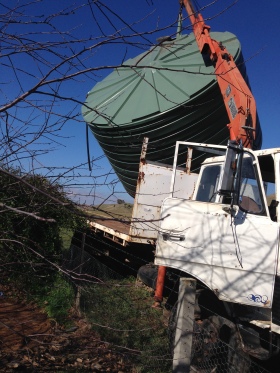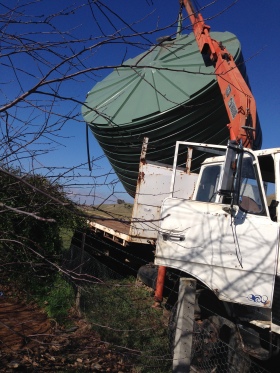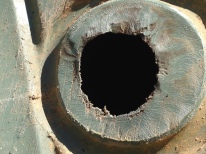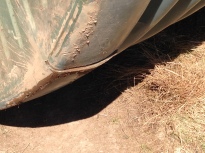 In some places people find entertainment in running up to a sleeping cow and tipping her over. Round here, instead, we like to tip our tanks over. Especially the empty ones that are leaking and need mending.
In some places people find entertainment in running up to a sleeping cow and tipping her over. Round here, instead, we like to tip our tanks over. Especially the empty ones that are leaking and need mending.
We use tanks for house water, garden water and stock water, filling them from the creek, or the river, or, in the case of drinking water, from the sky. With a hot summer coming it’s important that they be reliable. Water is, literally, life.
In particular, we have a system of troughs that relies on a windmill pumping from the creek up to a tank on a ridge, and from there pipes take the water to several stock troughs in the valley.
 I want to add a couple more troughs to the system to provide water for the new paddocks we’ve created with the tree-planting, so the system needs to be very reliable. The old galvanized steel tank was replaced in 2007 with a new poly tank on the old concrete base.
I want to add a couple more troughs to the system to provide water for the new paddocks we’ve created with the tree-planting, so the system needs to be very reliable. The old galvanized steel tank was replaced in 2007 with a new poly tank on the old concrete base.
While poly tanks are the cheapest type to get, it turns out they are not necessarily long-lasting. Andrew our neighbour had been telling me that “the poly tank on the hill is leaking” for several months, but I thought he was talking about his own leaking poly tank. But no, there were two leaking tanks, one of them ours.
He suggested he could throw some concrete mixture into the bottom of the tank to seal the leak in the base. I looked into it and found that was unlikely to work because nothing much sticks to the oil-based poly and the water would probably work its way around the concrete and out through the hole.
So we needed to fix the hole.
I found some suggestions for fixing tank damage that involved screwing two plates together with rubber strips between them that would make a seal. Or potentially there’d just be more holes in the tank. I found out that splits could be discouraged from spreading further by drilling the ends with round holes, then repairing them with patches.
The best way to fix a poly tank is to use a plastic extrusion welder, after drilling out the end of any splits, then melting additional plastic over the top as a reinforcing patch. So then I had a couple of weeks trying to find someone who would do that. Online, I found a name of someone in Bega, 180km away, who didn’t answer my calls.
 I contacted Bushman Tanks who did not give an actual warranty on their tanks, because the original company went bust in 2009, presumably because they made tanks that were thin, poorly reinforced, and split. But they do offer a 40% off on a new tank “for goodwill”. It turned out our tank was actually from “Team Poly” who have a more complicated warranty arrangement which I’m still following up. Anyway, the Bushman people recommended Grant from Tumut, 160km away, as the closest plastic repairer. His repairs are much more reasonable than getting a new tank, but he does charge mileage for coming, so we decided to have a tank-tipping party and get our tank and Andrew’s tank fixed on the same day.
I contacted Bushman Tanks who did not give an actual warranty on their tanks, because the original company went bust in 2009, presumably because they made tanks that were thin, poorly reinforced, and split. But they do offer a 40% off on a new tank “for goodwill”. It turned out our tank was actually from “Team Poly” who have a more complicated warranty arrangement which I’m still following up. Anyway, the Bushman people recommended Grant from Tumut, 160km away, as the closest plastic repairer. His repairs are much more reasonable than getting a new tank, but he does charge mileage for coming, so we decided to have a tank-tipping party and get our tank and Andrew’s tank fixed on the same day.
Then Andrew’s friend James O’Keefe turned up with a third tank on his truck. But that was great, because he also brought along his crane that could lift and shuffle the tanks to any angle needed for the repairs. James’ tank was in pretty bad shape. I worried he was wasting his time.
Grant didn’t mind though and repaired them all.
While watching and waiting, James and I noticed some swallows coming out of the overflow pipe with lumps of mud. It turned out they’d made a nest inside the tank near the pipe. When I leaned in through the access hole I could see where the nest had been attached, but it had fallen into a muddy lump at the bottom and disintegrated. It was impossible to tell if there had been eggs. I could see why birds would like it in there, because it was very warm and out of the wind. James commented “Yeah, great place for a nest except when the chicks fall out of the nest straight into the water”.
 Our hill tank went back on its concrete base, but needed to have a centre pole that supports the roof put back in before it could be filled. It had to have water in it as soon as possible or the high winds on the ridge would send it rolling down the hill like a giant bowling ball, flattening fences and, even worse, putting new splits in the sides.
Our hill tank went back on its concrete base, but needed to have a centre pole that supports the roof put back in before it could be filled. It had to have water in it as soon as possible or the high winds on the ridge would send it rolling down the hill like a giant bowling ball, flattening fences and, even worse, putting new splits in the sides.
But it turned out ordinary ladders don’t fit in the access holes for a tank. You need a special narrow one that allows a person to squeeze in as well. Luckily we had one for our big concrete house tank at Esdale. This ladder’s extremely long and heavy to lift and transport. I also worried that the sharp end of it would put a new hole in the bottom of the tank.
Andrew solved that by attaching a foot made of poly pipe that would diffuse the weight of the ladder over a wider area and got the pole back in place with help from a support team.
At least that’s three tanks that now work and aren’t just littering the landscape. Now we just need to get that discounted replacement tank.





Bravo, Fiona!
LikeLike
Well, it’s all easy when you have a crane…
LikeLike
What a saga Fiona! However it is great that you have accomplished so much. Cheers Mum
LikeLike
I love all this heavy equipment. You just don’t get to play with it in normal life.
LikeLike